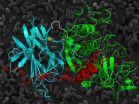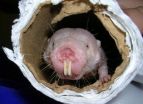(Press-News.org) The bacterium Clostridium difficile causes antibiotic-related diarrhoea and is a growing problem in the hospital environment and elsewhere in the community. Understanding how the microbe colonises the human gut when other "healthy" microbes have been destroyed during a course of antibiotics might lead to new ways to control infection. An important clue was reported recently in an open access article published in the journal Acta Crystallographica Section D Biological Crystallography. [Bradshaw et al. (2014). Acta Cryst. D70, 1983-1993; doi:10.1107/S1399004714009997]
Ravi Acharya of the University of Bath, UK, and colleagues have reported the first crystal structure of the C. difficile surface protein Cwp84. This cysteine protease enzyme is found on the surface of the bacterium and assists with production of the microbe's surface-layer, which is likely to play an essential step in the colonisation of the gut. The enzyme cleaves a single polypeptide (surface-layer protein A; SlpA) into low- and high-molecular-weight subunits. Now, Acharya and colleagues have identified three critical regions in a mutant of the enzyme that could represent novel targets for drugs to attack C. difficile by blocking maturation of its surface layer during colonisation.
While C. difficile can be present in the normal, healthy gut (3-5% of adults), when a patient requires treatment for infection with broad-spectrum antibiotics, other protective intestinal microbes are eradicated in the process and the incidence increases to about 20%. This leaves space for the pathogenic C. difficile to grow rapidly unhindered leading to the release of toxins that cause bloating, pain and severe diarrhoea. Sometimes potentially life-threatening pseudo-membranous colitis or toxic megacolon occurs (about 5 to 8% of patients). Outbreaks occur when people ingest the spores, often in contaminated medical facilities and C. difficile is known to kill tens of thousands of people every year worldwide. Mild cases are often resolved by simply halting antibiotic treatment but in more severe cases last-line antibiotics such as vancomycin and metronidazole are often needed. Worryingly, the relapse rate is 20 to 30%.
The team explains that while Cwp84 is essential for correct surface layer formation it may also break down extracellular proteins, such as fibronectin, laminin and vitronectin which are found in the body. Nevertheless, blocking its activity either genetically or chemically prevents proper growth of bacterial colonies even if this is not in itself bactericidal. Disruption of the colonization process might therefore be possible allowing healthy microbes to repopulate the gut and stifle the spread of C. difficile.
The researchers carried out X-ray crystallography at station I03 at Diamond Light Source in Didcot, UK. The resulting high-resolution (1.4 angstrom) diffraction data revealed the structure of the N-terminal propeptide, the cysteine protease domain, and a previously uncharacterized "linker" region that is 170 amino acids long. The linker lies between the cysteine protease domain and the repeat region of Cwp84 which holds it onto the cells surface. The linker region binds calcium and resembles a group of proteins known as lectins, so may have an affinity for carbohydrates which may be vital for correct cell wall processing. The same motifs are present in other types of Clostridium microbes as well as ancient single-celled organisms known as archaea.
The team suggests that the insights their research offers in terms of C. difficile surface layer growth and how this relates to gut colonization could be exploited in developing a new type of drug to treat infection-anti-colonization inhibitors.
INFORMATION:
The difficult question of Clostridium difficile
2014-08-19
ELSE PRESS RELEASES FROM THIS DATE:
Zebrafish help to unravel Alzheimer's disease
2014-08-19
New fundamental knowledge about the regulation of stem cells in the nerve tissue of zebrafish embryos results in surprising insights into neurodegenerative disease processes in the human brain. A new study by scientists at VIB and KU Leuven identifies the molecules responsible for this process.
Zebrafish as a model
The zebrafish is a small fish measuring 3 to 5 cm in length, with dark stripes along the length of its body. They are originally from India, but also a popular aquarium fish. Zebrafish have several unusual characteristics that make them popular for scientific ...
Why global warming is taking a break
2014-08-19
Global warming is currently taking a break: whereas global temperatures rose drastically into the late 1990s, the global average temperature has risen only slightly since 1998 – surprising, considering scientific climate models predicted considerable warming due to rising greenhouse gas emissions. Climate sceptics used this apparent contradiction to question climate change per se – or at least the harm potential caused by greenhouse gases – as well as the validity of the climate models. Meanwhile, the majority of climate researchers continued to emphasise that the short-term ...
Has the puzzle of rapid climate change in the last ice age been solved?
2014-08-19
During the last ice age a large part of North America was covered with a massive ice sheet up to 3km thick. The water stored in this ice sheet is part of the reason why the sea level was then about 120 meters lower than today. Young Chinese scientist Xu Zhang, lead author of the study who undertook his PhD at the Alfred Wegener Institute, explains. "The rapid climate changes known in the scientific world as Dansgaard-Oeschger events were limited to a period of time from 110,000 to 23,000 years before present. The abrupt climate changes did not take place at the extreme ...
How steroid hormones enable plants to grow
2014-08-19
Plants are superior to humans and animals in a number of ways. They have an impressive ability to regenerate, which enables them to regrow entire organs. After being struck by lightning, for example, a tree can grow back its entire crown. But there is one major downside to life as a plant: They are quite literally rooted to the habitats in which they live and therefore completely at the mercy of the elements. In response to this dilemma, plants have developed mechanisms that enable them to rapidly adapt their growth and development to changes.
Plant hormones are important ...
First indirect evidence of so-far undetected strange baryons
2014-08-19
UPTON, NY-New supercomputing calculations provide the first evidence that particles predicted by the theory of quark-gluon interactions but never before observed are being produced in heavy-ion collisions at the Relativistic Heavy Ion Collider (RHIC), a facility that is dedicated to studying nuclear physics. These heavy strange baryons, containing at least one strange quark, still cannot be observed directly, but instead make their presence known by lowering the temperature at which other strange baryons "freeze out" from the quark-gluon plasma (QGP) discovered and created ...
Hope for healthy hearts revealed in naked mole rat studies
2014-08-19
SAN ANTONIO (Aug. 14, 2014) — Cardiovascular disease is the greatest killer of humans the world over, presenting huge financial and quality-of-life issues. It is well known that the heart becomes less efficient with age in all mammals studied to date, even in the absence of overt cardiac disease. However, scientists still don't have a good understanding of how to prevent these functional declines that ultimately may lead to debilitating cardiovascular disease.
The longest-lived rodent, the naked mole rat, beats these odds and escapes cardiovascular aging, at least to ...
Men fare worse than women in China regarding discrimination among obese workers
2014-08-19
New research that analyzes economic disparity among obese Chinese adults shows that there is no wage disparity for obese women in China, but there is pay inequality among obese men.
Women in China make less on average than men, but the study results showed no disparity in wages because of body weight. Results of the study for men showed increasing wage disparities by occupation when gaining weight.
The study, "The Obesity Pay Gap: Gender, Body Size, and Wage Inequalities: A Longitudinal Study of Chinese Adults, 1991-2009," which will be presented at the 109th Annual ...
Purdue ag economists: Shale oil 'dividend' could pay for smaller carbon footprint
2014-08-19
WEST LAFAYETTE, Ind. - Unanticipated economic benefits from the shale oil and gas boom could help offset the costs of substantially reducing the U.S.'s carbon footprint, Purdue agricultural economists say.
Wally Tyner and Farzad Taheripour estimate that shale technologies annually provide an extra $302 billion to the U.S. economy relative to 2007, a yearly "dividend" that could continue for at least the next two decades, Tyner said.
Using an economic model, they found that "spending" part of this dividend on slashing the nation's carbon emissions by about 27 percent ...
NASA's RXTE satellite decodes the rhythm of an unusual black hole
2014-08-19
Astronomers have uncovered rhythmic pulsations from a rare type of black hole 12 million light-years away by sifting through archival data from NASA's Rossi X-ray Timing Explorer (RXTE) satellite.
The signals have helped astronomers identify an unusual midsize black hole called M82 X-1, which is the brightest X-ray source in a galaxy known as Messier 82. Most black holes formed by dying stars are modestly-sized, measuring up to around 25 times the mass of our sun. And most large galaxies harbor monster, or supermassive, black holes that contain tens of thousands of times ...
Study of African dust transport to South America reveals air quality impacts
2014-08-19
MIAMI – A new study that analyzed concentrations of African dust transported to South America shows large seasonal peaks in winter and spring. These research findings offer new insight on the overall human health and air quality impacts of African dust, including the climate change-induced human health effects that are expected to occur from increased African dust emissions in the coming decades.
Researchers from the University of Miami (UM) Rosenstiel School of Marine and Atmospheric Science and colleagues analyzed the dust concentrations in aerosol samples from two locations, ...





